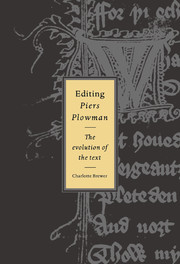Book contents
- Frontmatter
- Contents
- Acknowledgements
- Abbreviations
- Note on the texts
- Introduction
- Part I The early phase
- Part II The late nineteenth century
- Part III The Skeat aftermath
- Part IV Chambers and Grattan, Knott and Fowler
- 12 Chambers 1909–1910
- 13 Chambers versus Knott
- 14 Chambers' graduate students
- 15 Chambers 1931
- 16 Chambers 1935–1942
- 17 The Chambers and Grattan collations
- 18 Grattan and Kane
- 19 Knott and Fowler, Donaldson, Mitchell, and Russell
- Part V The Athlone Press edition
- Part VI Epilogue: the Athlone aftermath: Schmidt, Pearsall, Rigg-Brewer, et al.
- Works cited
- General index
- Index of manuscripts
- CAMBRIDGE STUDIES IN MEDIEVAL LITERATURE
16 - Chambers 1935–1942
Published online by Cambridge University Press: 20 August 2009
- Frontmatter
- Contents
- Acknowledgements
- Abbreviations
- Note on the texts
- Introduction
- Part I The early phase
- Part II The late nineteenth century
- Part III The Skeat aftermath
- Part IV Chambers and Grattan, Knott and Fowler
- 12 Chambers 1909–1910
- 13 Chambers versus Knott
- 14 Chambers' graduate students
- 15 Chambers 1931
- 16 Chambers 1935–1942
- 17 The Chambers and Grattan collations
- 18 Grattan and Kane
- 19 Knott and Fowler, Donaldson, Mitchell, and Russell
- Part V The Athlone Press edition
- Part VI Epilogue: the Athlone aftermath: Schmidt, Pearsall, Rigg-Brewer, et al.
- Works cited
- General index
- Index of manuscripts
- CAMBRIDGE STUDIES IN MEDIEVAL LITERATURE
Summary
In 1935 Chambers published a biography of Thomas More, indicating that his productivity in some respects continued apace. But still he doggedly returned to Piers Plowman. In the same year the Huntington Library funded a trip to San Marino, California to examine its manuscripts, where Chambers worked closely with the librarian, R. B. Haselden, and produced an important article on the library's Piers Plowman manuscripts, identifying Hm 143, the manuscript he had looked at when it came on to the market in 1924 (see p. 254 above), as the most valuable of the C-Text manuscripts. This was swift, efficient, and productive work; presumably he was highly stimulated by the change in scene. Max Ferrand, a Director of the Huntington Library, wrote affectionately to him some years later: ‘Your visit to San Marino was one of the most satisfactory of all our visiting scholars – because you cleared up your job.’ And he goes on to say, somewhat over-optimistically as poor Chambers must have felt, ‘It is to be hoped that when the war is over, the several texts of Piers Plowman will be published and that work of scholarship cleared off for a generation or two.’ But the important finding of Chambers' study, that Hm 143 was the most significant extant C-MS, merely underlined the depressing unpredictability of Piers Plowman textual work. The two graduate students, Allen and Carnegy, who had been set to work on the C-Text in order to clear the ground for the A-Text, had analysed the manuscripts in ignorance of Hm 143.
- Type
- Chapter
- Information
- Editing Piers PlowmanThe Evolution of the Text, pp. 284 - 302Publisher: Cambridge University PressPrint publication year: 1996

